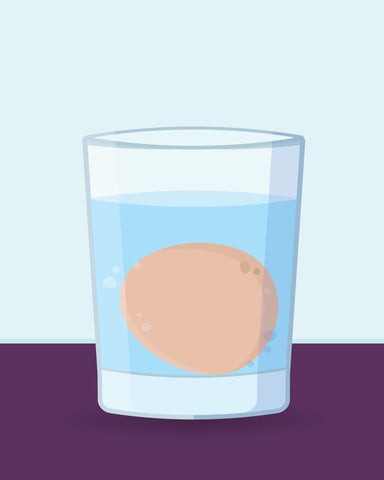Like all perishable foods, eggs have a shelf life, but their natural packaging provides a significant advantage. Despite the USDA’s mandated washing process, which can slightly reduce their protective outer layer, eggs still boast a considerable window of freshness. Generally, you can consume eggs for up to 45 days from their processing date – often just a few days after they were laid. However, if you’re unsure about the age of your eggs and want to be certain they are still good to eat, there are several simple and effective methods you can use. This guide will walk you through exactly how to tell if your eggs are fresh and safe for your next meal.
The Simple Water Test to Check Egg Freshness
One of the easiest and most reliable methods to test egg freshness is the water test. Here’s how to do it:
- Prepare a Bowl: Fill a bowl or a deep glass with approximately four inches of cold water.
- Gently Submerge the Egg: Carefully place your egg or eggs into the water.
- Observe the Egg’s Behavior: Watch what happens to the egg in the water.
Interpreting the Results:
-
Sinks to the Bottom and Lays Flat: If the egg immediately sinks to the bottom of the bowl and rests flat on its side, you have a very fresh egg. This is because a fresh egg has a small air cell inside, causing it to be dense and sink easily.
-
Sinks but Stands Upright: If the egg sinks to the bottom but stands upright on its small end, it’s still good to eat, though it’s not as fresh as the first case. As eggs age, the air cell inside grows larger, making the egg more buoyant. Eggs in this category are perfectly safe and nutritious to eat, and some even argue they are better for certain cooking methods. For instance, slightly older eggs are fantastic for hard boiling because they are easier to peel, and the whites whip up to greater volumes for desserts like meringues.
- Floats to the Surface: If the egg floats to the top of the water, it indicates that the egg is no longer fresh and should be discarded. This happens when the air cell has expanded significantly over time as air permeates the shell. A floating egg signifies that it’s likely too old to consume safely.
Other Ways to Tell If Eggs Have Gone Bad
Besides the water test, you can use your senses to check for egg freshness. Here are additional methods to help you determine if an egg is still good:
The Smell Test
The smell test is a straightforward and highly effective way to identify a bad egg.
- Crack the Egg into a Clean Bowl: Crack the egg into a clean, empty bowl or dish. It’s important to crack it into a separate bowl rather than directly into your mixing bowl, just in case it is bad, to avoid contaminating other ingredients.
- Sniff Closely: Bring your nose close to the bowl and take a sniff. A fresh egg will have very little to no discernible smell.
- Look for a Pungent or Foul Odor: If you detect a strong, unpleasant, or sulfurous smell, the egg has likely gone bad. This foul odor is a clear indicator of spoilage, usually caused by bacteria that have entered the egg. If it smells bad, it’s best to err on the side of caution and throw it away.
Visual Inspection: Appearance
After cracking the egg, take a close look at its appearance.
- Inspect the Shell (Inside): Examine the inside of the eggshell for any unusual discoloration, such as black or brown spots. These spots could indicate mold growth inside the egg, which means it’s spoiled.
- Check for Blood Spots: It’s important not to confuse blood spots with signs of spoilage. Small dark red or brown spots, known as blood spots, can sometimes be found in the egg white or yolk. These are caused by ruptured blood vessels during egg formation. Blood spots do not indicate spoilage and the egg is still safe to eat. You can either remove the blood spot with a spoon or cook the egg as normal.
- Observe the Egg White and Yolk: A fresh egg white should be somewhat thick and gel-like, and the yolk should be round and stand high.
Egg White Consistency
The consistency of the egg white can also provide clues about its freshness.
- Runny Egg White: As eggs age, the egg white tends to become thinner and more watery. This is due to carbon dioxide escaping through the shell, which affects the egg white proteins.
- Check for Excessively Watery Whites: While a slightly runny egg white doesn’t necessarily mean the egg is bad, very watery whites, especially in conjunction with an uncertain expiration date, suggest the egg is older. If you notice extremely loose, watery egg whites, it might be best to use a fresher carton, especially if you are concerned about freshness. However, runny egg whites alone are not a definitive sign of spoilage and should be considered along with other tests if you’re unsure.
Conclusion: Trust Your Senses and Stay Safe
Determining if eggs are good to eat doesn’t have to be a guessing game. By using the simple water test and paying attention to smell, appearance, and egg white consistency, you can confidently assess the freshness of your eggs. When in doubt, it’s always best to err on the side of caution and discard any eggs that you suspect might be spoiled. Using these tips will help ensure your meals are both delicious and safe.


